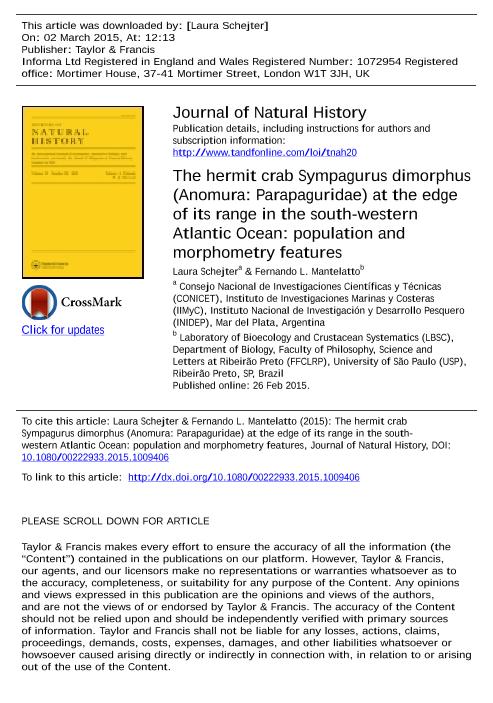Mostrar el registro sencillo del ítem
dc.contributor.author
Schejter, Laura

dc.contributor.author
Mantelatto, Fernando L.
dc.date.available
2018-06-29T17:11:11Z
dc.date.issued
2015-09
dc.identifier.citation
Schejter, Laura; Mantelatto, Fernando L.; The hermit crab Sympagurus dimorphus (Anomura: Parapaguridae) at the edge of its range in the south-western Atlantic Ocean: population and morphometry features; Taylor & Francis Ltd; Journal of Natural History; 49; 33-34; 9-2015; 2055-2066
dc.identifier.issn
0022-2933
dc.identifier.uri
http://hdl.handle.net/11336/50675
dc.description.abstract
Sympagurus dimorphus is one of the 12 hermit crab species recorded for Argentinean waters. Despite the high abundance registered in some scallop fishing grounds, its biology remains little known. In the present study, we analysed some population features of S. dimorphus living in symbiosis with Epizoanthus paguricola from a series of samples taken in the Argentine Sea, south-western Atlantic Ocean. Our results showed that S. dimorphus was commonly found from 40ºS to lower latitudes, in a patchy distribution along the shelf-break front. The overall sex ratio was 1:1. The smallest ovigerous female measured 6 mm in cephalothoracic shield length and this size was used as parameter to define the size of juveniles. The sex ratio size class pattern corresponded to Type IV or anomalous curve. S. dimorphus is a dimorphic species, as evidenced by the larger size of the males and the positive allometric growth of the right cheliped. The species also showed asymmetry, with the left uropod always larger than the right one. To the best to our knowledge, this is the first report on population features and relative growth for a member of the genus, based on long-term sampling. This species presents a patchy distribution along the shelf-break of Argentina. Its density tended to decrease over the five-year sampling period regarding the recruitment of hermits associated with colonies of zoanthids. In addition, the relatively homogeneous nature of this refuge does not seem to influence the growth of the hermit crab, which presents sexual dimorphism in relation to the sex/size conditions.
dc.format
application/pdf
dc.language.iso
eng
dc.publisher
Taylor & Francis Ltd

dc.rights
info:eu-repo/semantics/openAccess
dc.rights.uri
https://creativecommons.org/licenses/by-nc-sa/2.5/ar/
dc.subject
Argentina
dc.subject
Hermit Crabs
dc.subject
Population Dynamics
dc.subject
Relative Growth
dc.subject
Sex Ratio
dc.subject.classification
Otras Ciencias Biológicas

dc.subject.classification
Ciencias Biológicas

dc.subject.classification
CIENCIAS NATURALES Y EXACTAS

dc.title
The hermit crab Sympagurus dimorphus (Anomura: Parapaguridae) at the edge of its range in the south-western Atlantic Ocean: population and morphometry features
dc.type
info:eu-repo/semantics/article
dc.type
info:ar-repo/semantics/artículo
dc.type
info:eu-repo/semantics/publishedVersion
dc.date.updated
2018-06-29T13:08:13Z
dc.journal.volume
49
dc.journal.number
33-34
dc.journal.pagination
2055-2066
dc.journal.pais
Reino Unido

dc.journal.ciudad
Londres
dc.description.fil
Fil: Schejter, Laura. Consejo Nacional de Investigaciones Científicas y Técnicas. Centro Científico Tecnológico Conicet - Mar del Plata. Instituto de Investigaciones Marinas y Costeras. Universidad Nacional de Mar del Plata. Facultad de Ciencia Exactas y Naturales. Instituto de Investigaciones Marinas y Costeras; Argentina. Instituto Nacional de Investigaciones y Desarrollo Pesquero; Argentina
dc.description.fil
Fil: Mantelatto, Fernando L.. Universidade de Sao Paulo; Brasil
dc.journal.title
Journal of Natural History

dc.relation.alternativeid
info:eu-repo/semantics/altIdentifier/doi/https://dx.doi.org/10.1080/00222933.2015.1009406
dc.relation.alternativeid
info:eu-repo/semantics/altIdentifier/url/https://www.tandfonline.com/doi/full/10.1080/00222933.2015.1009406
Archivos asociados
